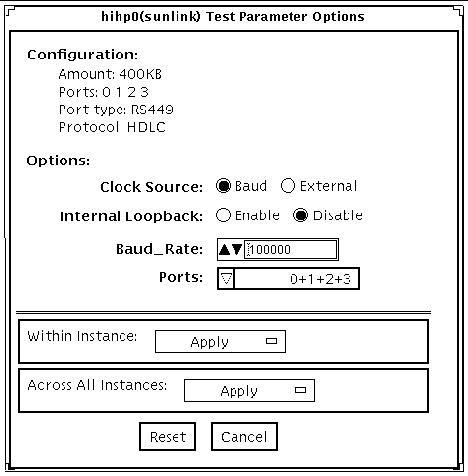| C H A P T E R 52 |
SunHSI Board Test (sunlink) |
The
sunlink
test verifies the functionality of the
SBus and PCI bus
SunHSI boards by using the
HDLC protocol.
sunlink
initializes and configures the selected channel.
boards by using the
HDLC protocol.
sunlink
initializes and configures the selected channel.
Next, sunlink opens a datagram socket and tries to modify the socket to accept ioctl communications with the driver, and receive synchronous mode information from it.
sunlink then opens the ports, linking the upper and lower layers with ioctl calls. After initialization, this test checks for activity before attempting to send or receive data. An error message is returned if activity is detected; otherwise the transmit buffer is filled with random data. Random data is used by default. You may also specify other patterns. The data is then transmitted. If the transmission succeeds, sunlink then receives the returned data and verifies that it is identical to what was sent. Finally, statistics about the send and receive are gathered from the socket.
A full sunlink test takes approximately eight minutes per port and makes a brief check of the board ports before the actual test begins. If the port is bad, the test immediately aborts and returns an error message.
This test will not pass unless you install the correct loopback connectors or port to port cables on the ports you are testing. The ports specified for test in the Options dialog box must have loopback connectors attached. See Appendix A for loopback connector part numbers and wiring instructions.
To reach the dialog box below, right-click on the test name in the System Map and select Test Parameter Options. If you do not see this test in the System Map, you might need to expand the collapsed groups, or your system may not include the device appropriate to this test. Refer to the SunVTS User's Guide for more details.
The Configuration field displays the available ports. (See FIGURE 52-1 .)

Refer to
Appendix
A of this manual for information on
Sunlink loopback cables and loopback connectors. Refer to the High Speed Serial Interface hardware manuals for information on null modem cables.
loopback cables and loopback connectors. Refer to the High Speed Serial Interface hardware manuals for information on null modem cables.
/opt/SUNWvts/bin/sunlink standard_arguments -o dev= device_name ,p= port# , P= data_pattern ,brate =speed_n ,I,C= clocksource
|
Specifies the bit rate transfer speed from 9600bs to 2.048mbs. |
|
The following is a typical command-line syntax for testing a SunHSI board:
This command tests the internal loopback for ports 0, 1, 2, and 3. It does not run for the port to port internal loopback test.
|
Note Note - 64-bit tests are located in the sparcv9 subdirectory: /opt/SUNWvts/bin/sparcv9/testname. If a test is not present in this directory, then it may only be available as a 32-bit test. For more information refer to 32-Bit and 64-Bit Tests. |
Copyright © 2002, Sun Microsystems, Inc. All rights reserved.